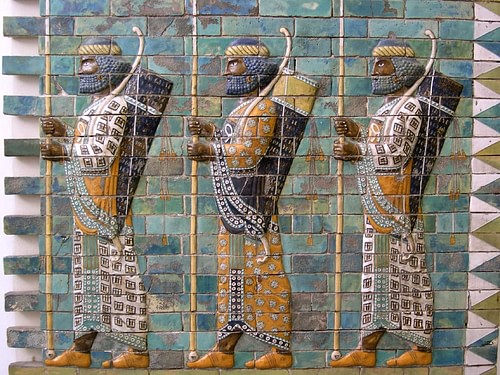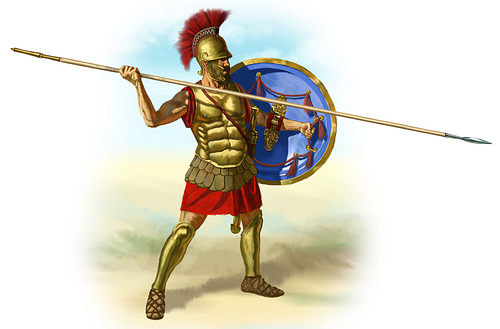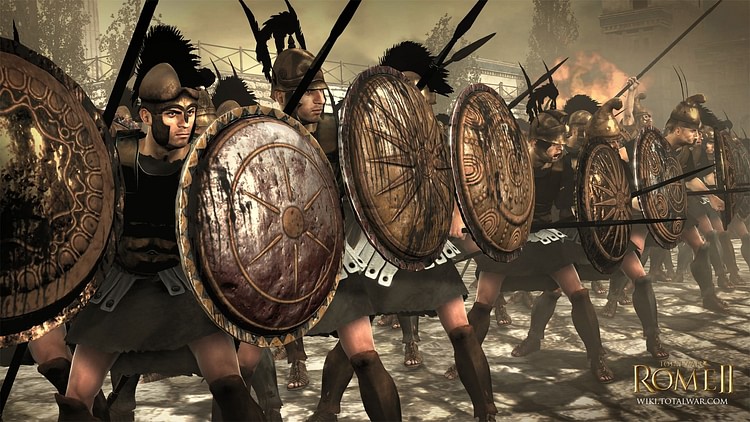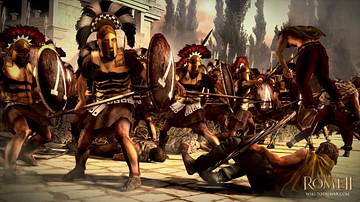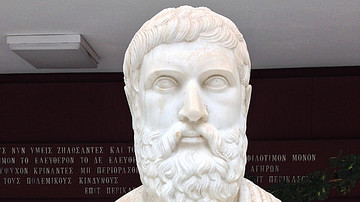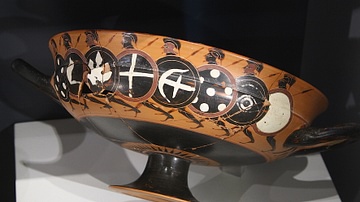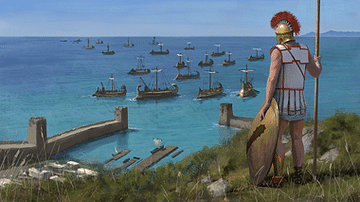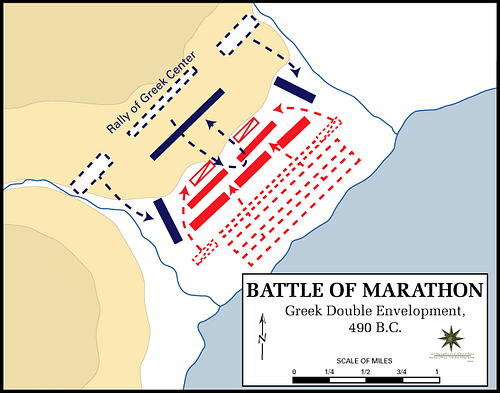
The Battle on the plain of Marathon in September 490 BCE between Greeks and the invading forces of Persian king Darius I (r. 522-486 BCE) was a victory that would go down in folklore as the moment the Greek city-states showed the world their courage and excellence and won their liberty. Although in reality the battle only delayed the Persians in their imperialistic ambitions and greater battles would follow, Marathon was the first time that mighty Persian Achaemenid Empire had been shown beatable and the battle would be represented in Greek art - literature, sculpture, architecture, and pottery - as a crucial and defining moment in the history of Greece.
The Persian Empire
Persia, under the rule of Darius I, was already expanding into mainland Europe and had subjugated Ionia, Thrace, and Macedonia by the beginning of the 5th century BCE. Next in King Darius' sights were Athens and the rest of Greece. Just why Greece was coveted by Persia is unclear. Wealth and resources seem an unlikely motive; other more plausible suggestions include the need to increase the prestige of the king at home or to quell once and for all a collection of potentially troublesome rebel states on the western border of the empire. The Ionian rebellion, the symbolic offering of earth and water in submission to the Persian satrap in 508 BCE, and the attack by Athens and Eretria on the city of Sardis in 499 BCE had not been forgotten either.
Whatever the exact motives, in 491 BCE Darius once again sent envoys to call for the Greeks' submission to Persian rule. The Greeks sent a no-nonsense reply by executing the envoys, and Athens and Sparta promised to form an alliance for the defence of Greece. Darius' response to this diplomatic outrage was to launch a naval force of 600 ships and 25,000 men to attack the Cyclades and Euboea, leaving the Persians just one step away from the rest of Greece. However, the invaders would meet their match in 490 BCE when the Greek forces led by Athens gathered at the plain of Marathon to defend their country from foreign subjugation.
The Persian Army
Overall command of the Persian army was in the hands of Datis as Darius did not lead the invasion in person. Second-in-command was Artaphernes, Darius' nephew, who perhaps led the Persian cavalry. The total strength of the Persian army is unclear, but judging by the number of ships there may have been some 90,000 men. The actual number of fighting men may have been two baivarabam units or 20,000-25,000 men. Most of these were archers with perhaps another 2,000 strong cavalry force. The Persian army actually came from various states across the empire but the Persians and Sakai were acknowledged as the best fighting units.
The Greek Army
The Greeks were led by either the Athenian Polemarch Kallimachos (also spelt Callimachus) or Miltiades who had actually fought under Darius in the latter's campaign in Scythia and so had valuable military intelligence of Persian warfare. The 1,000 Plataeans were commanded by Arimnestos and the Athenians fielded some 9,000 hoplites. The total force is estimated between 10,000 and 20,000 but was probably nearer the lower figure.
Hoplites v Archers
The two opposing armies were essentially representative of the two approaches to classical warfare - the Persians favoured long-range assault using archers followed up with a cavalry charge, whilst Greek warfare favoured heavily-armoured hoplites, arranged in a densely packed formation called the phalanx, with each man carrying a heavy round bronze shield and fighting at close quarters using spears and swords. The Persian infantry carried a lightweight (often rectangular) wicker shield (spara) and were armed with a long dagger or curved sword (kopis), a short spear, and composite bow. Typically, those with shields (sparabarai) formed a defensive barrier whilst from behind the archers fired their arrows. The Persian forces also included a couple of 1,000-strong units (hazarbam) of elite spear-bearers (aristabara). They had lighter armour than the hoplite, usually wearing a tunic (with perhaps bronze scales attached or a leather cuirass for some), colourfully patterned trousers, boots, and a soft hood.
The Persian cavalry were armed as the foot soldiers, with a bow and an additional two javelins for throwing and thrusting. Cavalry, usually operating on the flanks of the main battle, were used to mop up opposing infantry put in disarray after they had been subjected to repeated salvos from the archers. Although the Persian tactic of rapidly firing vast numbers of arrows into the enemy must have been an awesome sight, the lightness of the arrows meant that they were largely ineffective against the bronze-armoured hoplites. At close quarters, the longer spears, heavier swords, better armour, and rigid discipline of the phalanx formation meant that the Greek hoplites would have all of the advantages, but the Persians could field superior numbers and their reputation was formidable.
Opening Positions
The Persian force first landed at Karystos and then Eretria in northern Euboea, sacking both cities before moving across the strait to the eastern end of the bay of Marathon on the 1st and 2nd of September. Marathon was chosen as a suitable landing point for the Persians because it provided ideal terrain for the cavalry units; indeed, the very name Marathon may derive from the wild fennel (marathos) which still grows on this exceptionally fertile plain. In addition, the site also had a nearby lake offering a plentiful supply of water for both men and horses. The advantages of the site are probably why Pisistratus also chose the spot to land c. 546 BCE on his way to establishing himself as tyrant of Athens. Here then, in the shelter of the Kynosoura peninsula, the Persians set up camp.
When the Greeks discovered the invasion point, there was some discussion amongst the Athenian strategoi or generals whether to stay or meet the invaders, but the latter was the option decided upon and on arrival at Marathon on the 3rd or 4th of September, they set up camp near the sanctuary of Hercules at the western end of the bay, to be shortly joined by the Plataeans. The Spartans, celebrated as the finest fighters in Greece, were unfortunately delayed in their mobilisation because they were involved in the sacred Karneia festival and may well have been preoccupied with a local revolt by the Messenians. In fact, the Spartans would miss the battle by a day.
The details of the battle, as with most early 5th-century BCE battles, are sketchy and contradictory between ancient sources. However, on the 11th of September, it seems that the Greeks drew up their battle lines in the centre of the bay whilst the Persians had embarked only half of their infantry. Forming a front eight men deep, the Greeks lengthened their lines to match the Persians and thinned out their centre group to four men deep. The Plataeans were positioned on the right flank whilst the Athenians were in the centre and on the left. The best Persian and Sakai troops commanded from the centre, perhaps as many as ten men deep. This was a common Persian tactic, so the thinning of the Greek hoplites in the centre may have been a deliberate tactic by Miltiades or Kallimachos to allow the flanks to envelop the Persians as they made progress in the centre. On the other hand, the Greeks could not afford a narrower front than the Persians as this would allow them to get behind the Greek lines at the wings and render the phalanx formation hopelessly exposed to attack. The two lines of men - invaders and defenders - stretched 1,500 metres long and they now stood just 1,500 metres apart.
Battle
The Persian cavalry is mysteriously absent from the battle scene, and once again ancient sources and modern historians reach no consensus. It may have been that Datis could not use them to good effect because of the sporadic trees which dotted the plain, or that he had in fact sent them (or was planning to send them) with other troops towards Athens, either in an attempt to take the city while the Greeks were at Marathon, or perhaps their very absence was to tempt the Greek army to engage in battle before the Spartans arrived.
Eventually, though, the infantry on both sides engaged in battle. Moving towards each other and perhaps with the Greeks running the final 400 metres whilst undoubtedly under fire from the Persian archers, the two armies clashed. A lengthy and bloody struggle ensued with eventually the centre of the Persians, perhaps predictably, pushing the weakened Greek centre back. However, both the right and left flank of the Greeks got the upper-hand of the Persians, driving them back. The lines were, therefore, broken and a confused melee was the result. The Persians, now routed on the left and right, fled back to their ships, but to reach them they had to cross a wide marshy area. In the confused retreat the Greek wings closed into the centre and attacked both the Persian centre and pursued the fleeing Persian flanks, inflicting heavy casualties. Fierce fighting continued around the Persian ships, and it was in this action that Kallimachos was killed. The Greeks captured seven ships of the enemy, but the rest of the fleet escaped with any Persians who had managed to climb aboard.
The Greeks had won a great victory. According to tradition 6,400 Persians were dead, for only 192 Greeks. The first figure is reasonably accurate but the latter is likely a great underestimate for propaganda purposes. The Persians were not finished though, as Datis now sailed for Cape Sounion in an attempt to attack Athens whilst the Greek army was away. The Greeks may have been alerted to this development by a traitor's shield signal from Mt. Pentelikos which was, perhaps unfairly, accredited to the Alkemeonidai clan. No doubt exhausted, the Greek army was, nevertheless, compelled to march back at the double to Athens to defend the city. Their arrival at night of the same day seems to have been enough to discourage the Persians anchored off Phaleron and the fleet withdrew back to Asia. At this point, 2,000 Spartans finally arrived but they were unnecessary for victory was complete.
The Aftermath
Back at Marathon, the dead were cremated and buried at the site (an unusual step and the burial mound is still visible today), and a commemorative column trophy was erected (fragments of which are now in the Archaeological Museum of Marathon). Sacrifices were made in thanks to the gods, notably 500 goats to Artemis Agrotera, and each year thereafter, a sacrifice was performed at the site, a ritual continued for another 400 years. The Athenians set up a column and statue of Iris (or Nike) on their acropolis in honour of Kallimachos, and his role in the victory and statues and war booty were dedicated at the great sanctuary of Delphi. The victory was also commemorated in Greek sculpture by the renowned sculptor Phidias - a bronze group at Delphi which included Apollo, Artemis, and Miltiades, and a colossal bronze Athena on the Athenian acropolis. A temple to Artemis Eukleia was built in Athens, and the battle was also the subject of the sculpture on the south side of the Temple of Athena Nike c. 425-400 BCE in Athens.
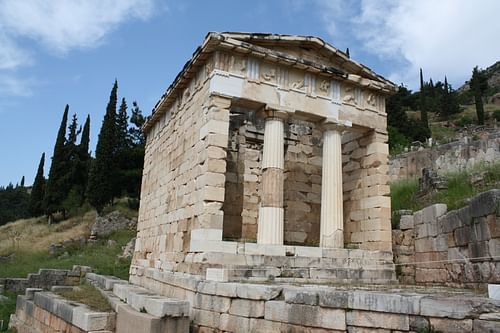
The victory was a great morale booster for the Greeks and all kinds of legends grew out of the events in September. Visions of the mythical Athenian hero Theseus during the battle and the intervention of Pan were just some of the stories which helped to explain how the Greeks had managed to defeat the mighty Persian army. Also, veterans of the battle carried a bull of Marathon (from the Hercules myth) device on their shield thereafter to proudly show their participation in this great victory.
Despite the Greek euphoria at victory, however, Persian ambitions were not dampened by defeat at Marathon, for within a decade King Xerxes continued his predecessor Darius' vision, and in 480 BCE gathered a huge invasion force to attack Greece, this time via the pass at Thermopylae. In August 480 BCE a small band of Greeks led by Spartan King Leonidas held the pass for three days, and at the same time, the Greek fleet managed to hold off the Persians at the naval Battle of Artemision. Together, these battles bought Greece time and allowed for the victories to come, first at Salamis in September 480 BCE where the Greek fleet manoeuvred the Persians into shallow waters, and at Plataea in August 479 BCE where the Greeks, fielding the largest hoplite army ever seen, won the battle which finally ended the Persian Wars in Greece.
The Marathon Race
One final legend of Marathon and one which has carried its name up to the present day is Herodotus' account of a long-distance messenger (hēmerodromos) named Phidippides. He was sent to enlist the help of the Spartans before the battle and he ran to Sparta, first stopping at Athens, a total distance of 240 km (a feat repeated by an athlete in 1983 CE). Later sources, starting with Plutarch in the 1st century CE, confuse this story with another messenger sent from Marathon after the battle to announce victory and warn of the Persian fleet's imminent arrival in Athens. In any case, it was from this second legend that a race - covering the same distance as the 42 kilometres between Marathon and Athens - was established in the first revival of the Olympic Games in 1896 CE to commemorate ancient Greek sporting ideals and the original games at Olympia. Fittingly, the first marathon race was won by a Greek, Spiridon Louis.
